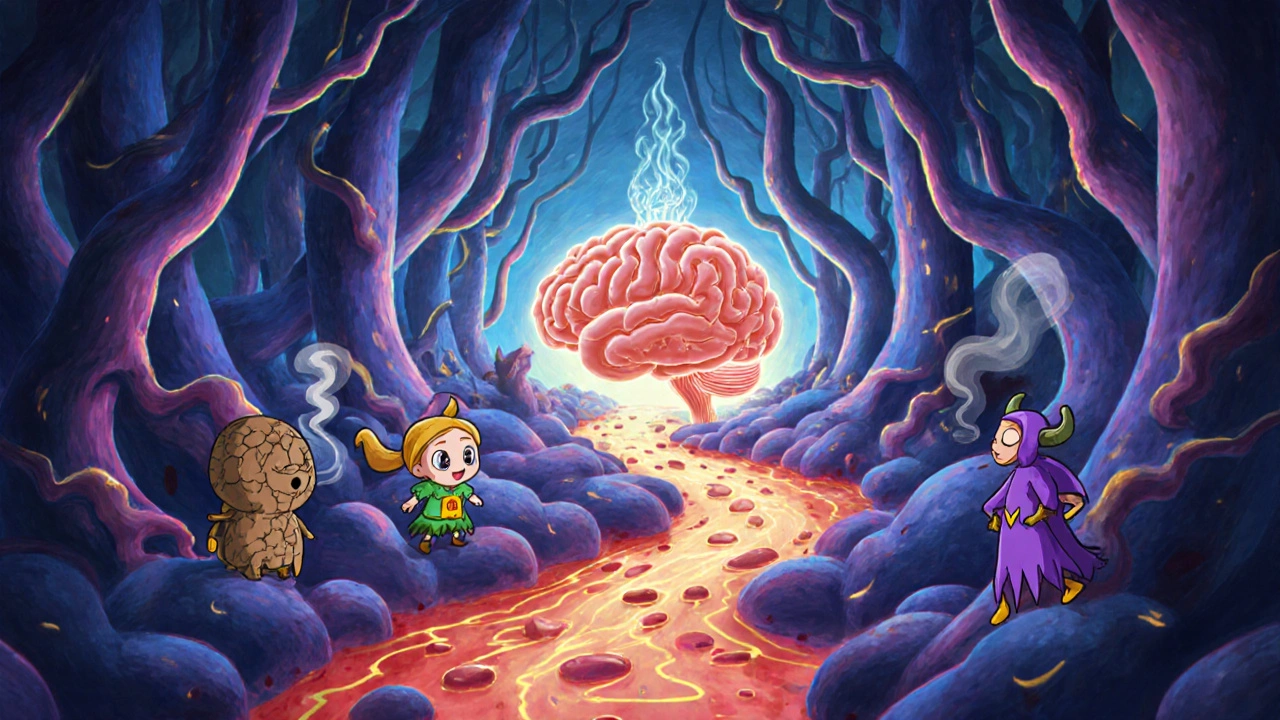 Oct, 15 2025
Oct, 15 2025
Ever wonder why a night out sometimes ends with a pounding headache? You’re not alone-many people notice that their head starts thumping after a few drinks. This article unpacks the science behind that link, showing how alcohol headache frequency is shaped by biology, drink choices, and personal factors, and gives you clear steps to keep the pain at bay.
Key Takeaways
- Alcohol can trigger headaches through dehydration, blood‑vessel changes, and inflammatory compounds called congeners.
- Red wine and dark spirits generally carry a higher risk than clear spirits or light beers.
- Staying hydrated, pacing yourself, and choosing low‑congener drinks are the most effective ways to cut down on alcohol‑related headaches.
- People with migraine or a history of frequent headaches are especially sensitive to alcohol’s effects.
- Seek professional care if headaches become severe, sudden, or are accompanied by neurological symptoms.
What a Headache Really Is
Headache is pain arising from structures of the head, such as blood vessels, nerves, muscles, or the meninges. The two most common categories are tension‑type headaches, which feel like a tight band around the skull, and migraines, which involve throbbing pain, nausea, and sensitivity to light. Understanding which type you usually get helps explain why alcohol might hit you harder on some days than others.
How Alcohol Moves Through Your Body
Alcohol consumption is the intake of ethanol‑containing beverages such as beer, wine, or spirits, which quickly enters the bloodstream and influences the central nervous system. Within minutes, ethanol reaches the brain, where it acts as a depressant, altering neurotransmitter activity. The liver works to break it down, producing acetaldehyde-a toxic by‑product that can cause flushing, nausea, and, crucially, headache.
Biological Triggers Linking Alcohol to More Headaches
Several mechanisms converge to raise headache frequency when you drink:
- Dehydration is the loss of body water that occurs because alcohol is a diuretic, prompting the kidneys to excrete more urine. Even a modest dip in hydration shrinks the volume of blood and reduces the cushioning around brain tissue, making the skull more sensitive.
- Vasodilation is the widening of blood vessels, especially in the brain, caused by ethanol’s impact on nitric oxide pathways. Dilated vessels can trigger the pain receptors that underlie migraine attacks.
- Blood‑sugar swings are fluctuations in glucose caused by alcohol’s interference with liver glucose production. Low blood sugar is a well‑known headache trigger, especially for people prone to hypoglycemia.
- Congeners are chemical by‑products of fermentation and distillation, such as methanol, tannins, and histamine, that vary by drink type and can provoke inflammation. Darker drinks generally contain more congeners.
- Acetaldehyde buildup is the accumulation of a toxic metabolite that irritates blood vessels and can lead to throbbing pain. People with slower aldehyde dehydrogenase activity feel the effects more intensely.

Which Drinks Are Most Likely to Spark a Headache?
| Drink | Typical Alcohol % | Congener Level | Headache Risk Rating |
|---|---|---|---|
| Light Beer (e.g., lager) | 4-5% | Low | Low |
| Wine (white, dry) | 11-13% | Medium | Medium |
| Red Wine | 12-15% | High (tannins, histamine) | High |
| Vodka (clear) | 40% | Very Low | Low‑Medium |
| Whiskey / Bourbon | 40-45% | High (dark‑age mellows, tannins) | High |
| Rum (dark) | 40% | High (molasses, sugar‑cane by‑products) | High |
Notice the pattern: clear, high‑proof spirits tend to have fewer congeners, while darker, aged beverages carry more of the chemicals that can irritate blood vessels. That doesn’t mean you can’t enjoy a glass of red wine-but being aware of the risk helps you plan.
Why Some People Are More Sensitive
Genetics plays a big role. For instance, individuals of East Asian descent often have a variant of the aldehyde dehydrogenase enzyme that processes acetaldehyde more slowly, leading to stronger flushing and headache responses. Meanwhile, people who already suffer from migraine have a lower threshold for vasodilation triggers, meaning even a small amount of alcohol can launch an attack.
Other personal factors include:
- Age and gender: Women, especially during hormonal fluctuations, report higher migraine prevalence and may notice alcohol‑related headaches more often.
- Sleep quality: Going to bed after drinking without enough REM sleep can amplify pain pathways.
- Medication interactions: Over‑the‑counter pain relievers combined with alcohol increase the risk of stomach irritation, which can manifest as a headache.
Practical Tips to Cut Down Alcohol‑Related Headaches
Here’s a checklist you can start using tonight:
- Hydrate before, during, and after drinking. Aim for at least one 8‑oz glass of water for every alcoholic drink.
- Choose low‑congener options. Clear spirits (vodka, gin) mixed with soda water are usually gentler than red wine or dark whiskey.
- Limit intake. For most adults, staying under two standard drinks per day reduces the chance of headache spikes.
- Eat a balanced meal. Protein and healthy fats slow alcohol absorption, preventing sudden blood‑sugar drops.
- Mind the pace. Sip slowly-roughly one drink per hour gives the liver time to metabolize ethanol.
- Track your triggers. Keep a simple log of what you drink, quantity, and any subsequent headache. Patterns emerge quickly.
- Consider supplements. Magnesium and riboflavin have evidence for reducing migraine frequency and may blunt alcohol‑related attacks.
If you notice that even a small amount of a particular drink consistently brings on pain, it’s a sign to either cut back or avoid that beverage altogether.

When to Seek Professional Help
Most occasional alcohol‑related headaches resolve with rest and hydration. However, you should contact a healthcare provider if you experience:
- Sudden, severe “thunderclap” pain, which could indicate bleeding.
- Neurological signs such as vision changes, weakness, or confusion.
- Headaches that last more than 72hours despite treatment.
- Frequent headaches (more than four per month) linked to alcohol use.
A clinician can evaluate for underlying conditions like chronic migraine, alcohol use disorder, or vascular issues, and may suggest prescription preventive medication.
Next Steps & Troubleshooting
If you’ve tried the hydration and low‑congener strategies but still wake up with a pounding head, experiment with a short “dry week” - no alcohol for seven days. Compare headache frequency before and after. If the improvement is dramatic, alcohol is likely a major trigger for you.
For those who can’t give up alcohol entirely, consider rotating drink types each week to see if certain beverages are less problematic. Keep a simple spreadsheet: date, drink type, volume, water glasses, headache rating (0‑10). Over a month, you’ll have a data‑driven picture of what works best.
Frequently Asked Questions
Can a single glass of wine really cause a migraine?
Yes. For many migraine sufferers, even a small amount of alcohol - especially red wine, which is high in congeners - can trigger the cascade of blood‑vessel dilation and inflammation that leads to a migraine.
Why do I get a headache after drinking beer but not after vodka?
Beer contains more carbonation and can cause faster alcohol absorption, while vodka is a low‑congener spirit. The combination of rapid absorption, carbonation‑induced bloating, and a slightly higher water content can make beer a bigger headache trigger for some people.
Is staying hydrated enough to prevent all alcohol‑related headaches?
Hydration dramatically reduces risk, but it doesn’t eliminate other factors like congeners, vasodilation, or individual enzyme deficiencies. Pairing water with low‑congener drinks yields the best results.
Should I take medication before drinking to stop a headache?
Over‑the‑counter pain relievers (ibuprofen or naproxen) can be taken pre‑emptively, but they should not be mixed with large amounts of alcohol due to stomach irritation and liver stress. Talk to a doctor for personalized advice.
Do I need a doctor if I only get a headache once a month after drinking?
Probably not, but it’s worth mentioning at your next routine check‑up. Frequent alcohol‑triggered headaches can evolve into chronic migraine, and a clinician can help you develop a prevention plan.

Rachael Tanner
October 15, 2025 AT 13:10Whoa, the link between booze and that thundering scalp ache is more than just “you drank too much.” Dehydration, those sneaky congeners, and the vasodilation roller‑coaster all team up to make the pain festival start. If you’re a migraine‑prone soul, even a modest sip can flip the switch on those blood‑vessel pain receptors. The article nails the biology, but remember your personal tolerance – genetics and hormone swings matter a lot. Bottom line: pick low‑congener drinks, hydrate like a champ, and keep a quick log of what gives you grief.
Debra Laurence-Perras
October 16, 2025 AT 05:00Totally agree, staying hydrated and swapping out the dark spirits for something clearer can really keep the headache monsters at bay. It’s all about small, smart choices that make nights fun without paying the morning price.
dAISY foto
October 16, 2025 AT 21:40Listen up, party people! I was that girl who used to think a night of wine meant a sunrise of glory, but the next morning? My head felt like a drum solo at a rock concert. I started keeping a tiny notebook in my pocket – every drink, every water glass, and the pain level on a 0‑10 scale. Guess what? When I swapped my usual glass of cabernet for a crisp vodka soda, the headache score dropped from an 8 to a meek 2.
Then came the dark rum experiment: I mixed a splash with ginger ale, added a dash of lime, and actually survived the night without the pounding. The secret? Low‑congener spirits and a solid water‑before‑drink habit.
One time I tried a dry week – no alcohol for seven days – and my migraine diary went from “daily terror” to “once in a blue moon.” That was a real‑eye‑opener!
Also, I discovered that eating a hearty meal with protein and healthy fats before drinking slows the booze’s assault on my blood sugar, so the dreaded dip never hits.
Don’t forget magnesium supplements; they’re a game‑changer for migraine‑prone folks and seem to blunt the alcohol‑induced attacks.
And hey, if you’re like me and love a good cocktail, try alternating your drink types each week – gin one week, whiskey the next – and see which one keeps the clouds away.
Remember, the body is a clever machine – give it water, give it food, and it’ll thank you with a clear head.
Finally, if your headaches start feeling like thunderclaps or come with weird visual distortions, don’t gamble – see a doc before it gets serious.
In short, be kind to yourself, pick your poison wisely, and hydrate like a fish.
Ramanathan Valliyappa
October 16, 2025 AT 21:41Hydration and low‑congener choices reduce headache incidence.
lucy kindseth
October 17, 2025 AT 14:20Here’s a quick cheat‑sheet: 1️⃣ One water glass per alcoholic drink, 2️⃣ Choose clear spirits or light beers if you’re prone to migraines, 3️⃣ Eat a balanced snack before you start, and 4️⃣ Keep a simple spreadsheet – date, drink, water, headache rating. This routine takes a few minutes but can save you a full day of misery. Also, magnesium or riboflavin supplements have some solid research backing for migraine prevention, so pop one if you’re looking for extra armor.
Nymia Jones
October 18, 2025 AT 07:00While your recommendations appear pragmatic, one must consider the insidious influence of governmental alcohol subsidies that perpetuate ignorance regarding congeners. The populace is systematically misled, and any advice that does not address this engineered dependency is, at best, superficial. I urge readers to scrutinize the provenance of their libations and demand transparency from manufacturers.
Karen McCormack
October 18, 2025 AT 23:40The interplay between ethanol and cerebral vasculature is a vivid illustration of how tiny molecules can orchestrate grand symphonies of sensation. One might ponder whether our modern penchant for socially sanctioned intoxication is a collective experiment in neurochemical alchemy. If the body responds with pain, perhaps the real question is not "what to drink" but "why we drink" in the first place. Yet, practical wisdom remains valuable: moderation, hydration, and awareness of personal triggers are the humble tools we possess.
Earl Hutchins
October 19, 2025 AT 16:20Great philosophical spin, Karen. To add, the evidence table in the article clearly shows vodka’s low‑congener rating, so swapping a glass of red for a mixed vodka can cut risk without sacrificing the social ritual.
Tony Bayard
October 20, 2025 AT 09:00I hear you, Earl. It’s amazing how a tiny tweak in drink choice can spare us from a day of agony. For anyone feeling overwhelmed, remember you’re not alone – a supportive community and a dash of self‑care go a long way in taming those dreaded post‑drink headaches.